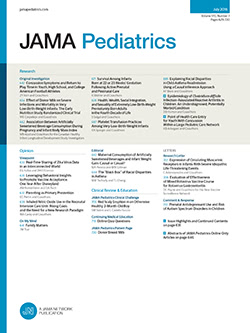Medicaid Reimbursement for Maternal Depression Screening and Care for Postpartum Depression
IF 18
1区 医学
Q1 PEDIATRICS
引用次数: 0
Abstract
ImportanceClinical guidelines recommend routine screening for postpartum depression (PPD) during well-child visits. All but 5 US states provide Medicaid reimbursement to pediatric practitioners for screening mothers for PPD during well-child visits, but little is known about how reimbursement affects screening, diagnosis, and treatment.ObjectiveTo evaluate the association between Medicaid reimbursement for PPD screening during well-child visits and screening, diagnosis, and treatment for mood or anxiety disorders in the postpartum year.Design, Setting, and ParticipantsThis cohort study used a difference-in-differences study design to analyze claims data and birth records obtained from the Colorado All Payer Claims Database for the period January 1, 2013, to December 31, 2019, for Medicaid-insured and commercially insured births that occurred between 2012 and 2018. Data were analyzed between February 16, 2024, and March 21, 2025.ExposureColorado Medicaid reimbursement for PPD screenings during well-child visits.Main Outcomes and MeasuresThe primary outcome was billed depression screens during well-child visits. Secondary outcomes were diagnoses of a postpartum mood or anxiety disorder and outpatient mental health care or prescription medication use during the postpartum year. We defined an indicator variable for before (2013) vs after (2014-2019) the Colorado Medicaid program began reimbursing for maternal depression screening during well-child visits on January 1, 2014.ResultsThis study included 137 867 births, 104 085 of which were paid by Medicaid and 33 782 of which were paid by commercial insurance. The mean (SD) age of mothers in the Medicaid-insured group during the 2013 prepolicy period was 25.6 (5.7) years compared with 31.7 (4.7) years among mothers in the commercially insured group; during the postpolicy period, the mean (SD) ages were 26.5 (5.7) years and 32.1 (4.4) years, respectively. During the prepolicy period, for births insured by Medicaid vs commercial insurance, the mothers were more likely to have been born outside the US (14.2% vs 10.3%;医疗补助对产妇抑郁症筛查和产后抑郁症护理的报销
临床指南建议在健康儿童就诊时进行产后抑郁症(PPD)的常规筛查。除了5个州外,美国所有州都向儿科医生提供医疗补助,用于在健康儿童就诊期间对母亲进行PPD筛查,但对报销如何影响筛查、诊断和治疗知之甚少。目的评估医疗补助报销在健康儿童就诊期间PPD筛查与产后一年情绪或焦虑障碍筛查、诊断和治疗之间的关系。设计、设置和参与者本队列研究采用差异中差异研究设计,分析了2013年1月1日至2019年12月31日期间从科罗拉多州所有付款人索赔数据库获得的索赔数据和出生记录,其中包括2012年至2018年期间医疗补助保险和商业保险的出生。研究人员分析了2024年2月16日至2025年3月21日之间的数据。暴露科罗拉多州医疗补助计划报销在健康儿童就诊期间的PPD筛查。主要结果和措施主要结果是在健康儿童访问期间进行抑郁症筛查。次要结果是产后情绪或焦虑障碍的诊断和产后一年中门诊精神卫生保健或处方药的使用。我们定义了一个指标变量,用于2014年1月1日科罗拉多州医疗补助计划开始报销在健康儿童就诊期间进行的母亲抑郁症筛查之前(2013年)和之后(2014-2019年)。结果本研究共纳入133767例新生儿,其中医疗补助支付104085例,商业保险支付33782例。2013年投保前医疗保险组母亲的平均(SD)年龄为25.6(5.7)岁,而商业保险组母亲的平均(SD)年龄为31.7(4.7)岁;术后平均(SD)年龄分别为26.5(5.7)岁和32.1(4.4)岁。在政策实施前,在医疗补助计划和商业保险承保的生育中,母亲更有可能在美国以外出生(14.2% vs 10.3%;P = 0.01),居住在农村地区(14.5% vs 8.1%;P, amp;肝移植;.001),没有完成高中或大学(24.8% vs 1.1%;P, amp;肝移植;.001),收入较低(80.3% vs 8.2%;P, amp;肝移植;措施)。在调整的差异中差异模型中,在医疗保险投保的母亲中,在健康儿童就诊期间进行母亲抑郁症筛查的报销与健康儿童就诊期间进行抑郁症筛查的概率增加9.60个百分点(95% CI, 9.10-10.00 ppt)相关(P <;.001),每次分娩增加0.18 (95% CI, 0.17-0.19)额外的健康儿童抑郁症检查(即,每100例分娩增加18次检查),诊断为产后情绪或焦虑障碍的可能性增加2.5个百分点(95% CI, 1.40-3.50个百分点),处方药减少3.3个百分点(95% CI, - 4.60 - 2.00个百分点)(P & <;.001),任何门诊心理健康治疗增加3.3个百分点(95% CI, 2.50-4.10个百分点)(P &;.001),与有商业保险的母亲相比。结论和相关性本队列研究的结果表明,在健康儿童就诊期间进行PPD筛查的医疗补助报销可能会增加产后一年中母亲的诊断率、产后情绪或焦虑障碍诊断率和门诊诊断率。健康儿童就诊期间PPD筛查的保险报销似乎是一项有希望的政策策略;然而,可能需要额外的干预措施来解决在儿科环境中进行筛查和转诊以及获得产后心理健康治疗的障碍。
本文章由计算机程序翻译,如有差异,请以英文原文为准。
求助全文
约1分钟内获得全文
求助全文
来源期刊

JAMA Pediatrics
PEDIATRICS-
CiteScore
31.60
自引率
1.90%
发文量
357
期刊介绍:
JAMA Pediatrics, the oldest continuously published pediatric journal in the US since 1911, is an international peer-reviewed publication and a part of the JAMA Network. Published weekly online and in 12 issues annually, it garners over 8.4 million article views and downloads yearly. All research articles become freely accessible online after 12 months without any author fees, and through the WHO's HINARI program, the online version is accessible to institutions in developing countries.
With a focus on advancing the health of infants, children, and adolescents, JAMA Pediatrics serves as a platform for discussing crucial issues and policies in child and adolescent health care. Leveraging the latest technology, it ensures timely access to information for its readers worldwide.
 求助内容:
求助内容: 应助结果提醒方式:
应助结果提醒方式:


